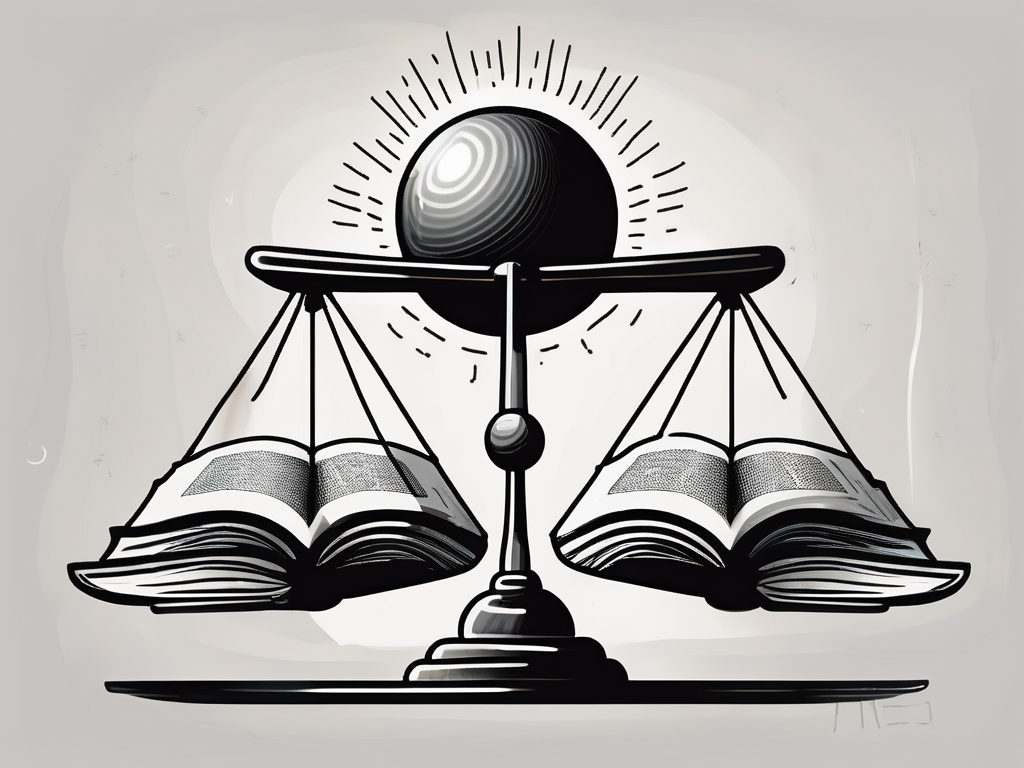There is no denying that religion plays a significant role in the lives of many individuals. It provides guidance, comfort, and meaning in a world that can often feel uncertain. Within each religious tradition, there are teachings and beliefs that form the foundation of faith. These teachings are known as doctrine, shaping how followers understand and interpret their religious practices.
Understanding the Concept of Doctrine
Doctrine, in its simplest form, refers to a set of principles or beliefs that define a particular religious faith or tradition. It serves as a framework for understanding and interpreting religious scriptures, rituals, and moral guidelines. Doctrine provides a sense of unity within a religious community and offers believers a shared understanding of their faith. It acts as a guiding light, helping individuals navigate their spiritual journey.
Doctrine often derives from sacred texts, such as the Bible, Quran, or Talmud, and is developed and refined over time by religious scholars, leaders, and communities. It serves as a source of authority and ensures that the teachings of a specific faith are passed down through generations.
When examining the concept of doctrine, it is important to delve deeper into its multifaceted nature. Doctrine is not simply a static set of beliefs, but rather a dynamic and evolving aspect of religious life. It is shaped by historical, cultural, and social contexts, reflecting the unique experiences and perspectives of each religious community.
The Role of Doctrine in Religion
Doctrine serves several fundamental roles within religion. Firstly, it provides a framework for understanding complex religious concepts and ideas. It helps believers make sense of the divine, the afterlife, and the purpose of human existence. Doctrine provides a set of answers, offering comfort and clarity in the face of existential questions.
Furthermore, doctrine acts as a moral compass, guiding individuals in their daily lives. It establishes ethical guidelines and values that followers are encouraged to uphold. Doctrine helps believers differentiate between right and wrong, and guides them in making decisions that align with their religious principles.
In addition, doctrine fosters a sense of community and identity within religious groups. It unites individuals who share the same beliefs and practices, creating a collective sense of purpose and belonging. Doctrine provides a common language and a shared understanding, allowing believers to connect and support one another.
Moreover, doctrine plays a crucial role in the preservation and transmission of religious traditions. It ensures the continuity of beliefs and practices across generations, safeguarding the core tenets of a faith. Through the study and adherence to doctrine, individuals deepen their knowledge and commitment to their religious heritage.
Differentiating Between True and False Doctrines
While doctrine plays a vital role in religious life, not all teachings are created equal. Throughout history, false doctrines have emerged, leading believers astray and causing confusion and division within religious communities.
Identifying and differentiating between true and false doctrines can be a challenging task. However, there are several key factors that can help guide believers in their discernment process.
One important aspect to consider is the alignment of a doctrine with the core principles and teachings of a particular faith. True doctrines are rooted in the foundational beliefs and values of a religious tradition, while false doctrines often deviate from or distort these principles.
Additionally, the historical context and origins of a doctrine can provide valuable insights. True doctrines are often supported by a rich historical lineage, tracing back to the origins of a faith and endorsed by respected religious authorities. False doctrines, on the other hand, may lack this historical continuity and may be introduced by individuals or groups with questionable credentials.
Furthermore, the impact and consequences of a doctrine can serve as a litmus test for its authenticity. True doctrines promote love, compassion, and justice, fostering harmony and unity within religious communities. False doctrines, on the contrary, may lead to division, exclusivity, and harmful practices.
Ultimately, the discernment of true and false doctrines requires a combination of critical thinking, spiritual discernment, and consultation with knowledgeable religious leaders and scholars. It is an ongoing process that requires believers to engage in deep reflection and study, ensuring that their faith is grounded in authentic and meaningful principles.
The Origins of False Doctrine
Understanding the origins of false doctrine provides valuable insight into how it has evolved over time and why it has permeated religious communities.
False doctrine, throughout history, has been a persistent challenge for religious communities. It has often been a source of confusion and division, leading believers astray from the true teachings of their faith. To fully comprehend the impact of false doctrine, it is essential to delve into its historical context and explore the factors that have contributed to its emergence.
Historical Context of False Doctrines
False doctrines can often be traced back to specific historical periods or events. In times of social and political upheaval, false teachings may arise as a result of individuals seeking to manipulate faith for personal gain or to exert control over others. These opportunistic individuals exploit the vulnerabilities of people who are searching for answers and guidance during times of uncertainty.
Throughout history, there have been numerous instances where false doctrines have emerged in response to societal changes. For example, during the Renaissance period, when Europe was experiencing a cultural and intellectual revolution, various sects and cults emerged, promoting unorthodox beliefs that challenged the established religious institutions. These movements often claimed to possess secret knowledge or a new interpretation of scripture, attracting followers who were disillusioned with the traditional teachings.
Similarly, in times of political turmoil, false doctrines have been used as a tool to consolidate power and control. Rulers and political leaders have historically used religion as a means to justify their actions and maintain their authority. They have manipulated religious teachings to suit their own agendas, distorting the truth and leading people astray.
Understanding the historical context in which false doctrines emerged can help shed light on their motivations and intentions. It allows us to recognize patterns and identify the underlying factors that contribute to their proliferation.
The Evolution of False Doctrines Over Time
False doctrines have the tendency to adapt and evolve as religious traditions and societies change. They often reflect the concerns and anxieties of the time, offering simplistic and sometimes deceptive answers to complex theological questions. The evolution of false doctrines underscores the importance of religious communities remaining vigilant and critically evaluating new teachings that deviate from established beliefs.
Throughout history, false doctrines have taken various forms and adapted to different cultural contexts. In ancient times, for example, there were numerous cults and sects that emerged, promising salvation through secret rituals or mystical experiences. These movements often attracted followers who were searching for a more personal and immediate connection with the divine.
In more recent times, false doctrines have taken advantage of technological advancements and the global spread of information. The rise of the internet and social media platforms has provided a fertile ground for the dissemination of misleading teachings. False prophets and charismatic leaders can now reach a wider audience, spreading their distorted interpretations of religious texts and manipulating vulnerable individuals.
Furthermore, the evolution of false doctrines is often intertwined with broader societal changes. As societies become more diverse and interconnected, religious communities are exposed to a wider range of beliefs and worldviews. This exposure can create a fertile ground for the emergence of syncretic movements that blend elements of different religions, resulting in the distortion of traditional teachings.
Recognizing the evolution of false doctrines is crucial for religious communities to maintain their integrity and protect their members from manipulation. It requires a commitment to critical thinking, rigorous theological study, and an unwavering dedication to the core principles of their faith.
Identifying False Doctrine
Recognizing false doctrine requires a nuanced understanding of its characteristics and the adverse effects it can have on believers and communities. False doctrine, often disguised as a persuasive alternative to established teachings, can lead individuals astray and cause division among believers. It is crucial for believers to be equipped with the knowledge and discernment necessary to identify and reject false teachings.
One common characteristic of false doctrines is a disregard for established religious authorities. False teachers often reject the guidance and wisdom of those who have studied and interpreted religious texts for generations. Instead, they rely on their own interpretations, which may be influenced by personal biases or agendas. This disregard for authority can lead to a distorted understanding of religious teachings and a departure from the core principles of faith.
Another characteristic of false doctrines is the reliance on selective interpretation of sacred texts. False teachers often cherry-pick verses or passages that support their own beliefs while ignoring or misinterpreting others that contradict their teachings. This selective approach to scripture can create a distorted and incomplete understanding of religious teachings, leading believers down a dangerous path.
Furthermore, false doctrines often promote exclusivity and division among believers. They may claim to possess the only true interpretation of religious teachings, thereby creating an “us versus them” mentality. This exclusivity can lead to the isolation of believers from the broader religious community and hinder the pursuit of unity and cooperation among different faith traditions.
Common Characteristics of False Doctrines
False doctrines often exhibit certain telltale signs that differentiate them from true teachings. These can include a disregard for established religious authorities, reliance on selective interpretation of sacred texts, and the promotion of exclusivity and division among believers. By understanding these common characteristics, believers can be more discerning and avoid being led astray.
It is important to note that false doctrines may not always be easily identifiable. They can be presented in a convincing and appealing manner, making it essential for believers to exercise critical thinking and engage in thorough examination of teachings before accepting them as truth.
The Impact of False Doctrine on Believers
False doctrine can have lasting and detrimental effects on individuals and communities. When individuals are exposed to false teachings, it can create confusion and uncertainty in their faith. They may question their beliefs, struggle with doubts, and experience a sense of spiritual disorientation. This confusion can lead to a weakening of one’s faith and a loss of trust in religious institutions.
Moreover, false doctrine can foster fear and guilt among believers. False teachers often manipulate their followers by instilling a sense of fear, warning them of dire consequences if they do not adhere to their teachings. This fear-based approach can lead to a constant state of anxiety and guilt, as individuals may feel that they are never living up to the expectations set by the false doctrine.
Ultimately, false doctrine can lead believers away from the core principles of their faith. It can distort their understanding of God, salvation, and the purpose of their religious practices. This departure from the truth can hinder spiritual growth and prevent believers from experiencing the fullness of their faith.
The impact of false doctrine on believers underscores the importance of fostering critical thinking, questioning, and engaging in open dialogue within religious communities. By encouraging believers to examine teachings critically and seek knowledge from reliable sources, religious communities can protect their members from the harmful effects of false doctrine and promote a deeper understanding of their faith.
The Dangers of False Doctrine
While it may be tempting to dismiss false doctrine as harmless or inconsequential, its dangers should not be underestimated.
Spiritual Implications of False Doctrine
False doctrine can lead individuals away from a genuine and authentic spiritual experience. By distorting the teachings of a faith, false doctrine can prevent believers from developing a deep and meaningful relationship with the divine. It can also breed cynicism and disillusionment, undermining the very foundation of faith.
Societal Consequences of False Doctrines
False doctrine can have far-reaching societal consequences. It can justify discrimination, prejudice, and violence, promoting division and perpetuating harmful ideologies and practices. Recognizing and combatting false doctrine is essential for fostering harmony, tolerance, and social justice within communities.
Counteracting False Doctrine
Identifying and combatting false doctrine requires a collective effort from individuals, religious leaders, and communities.
Strategies for Recognizing and Rejecting False Doctrine
Developing critical thinking skills, deepening theological knowledge, and engaging in open dialogue are crucial strategies for recognizing and rejecting false doctrine. By actively questioning and critically evaluating teachings, believers can guard against being misled and ensure that their faith remains grounded in truth.
The Role of Religious Leaders in Combating False Doctrine
Religious leaders have a significant responsibility in combatting false doctrine. They must provide guidance, support, and accurate teachings to their congregations. By promoting education, fostering dialogue, and addressing the concerns and questions of believers, religious leaders can play a pivotal role in safeguarding the integrity of faith communities.
Closing Thoughts
False doctrine has the potential to disrupt religious communities, causing confusion, disillusionment, and division. By understanding the concept of doctrine, differentiating between true and false teachings, and actively combatting the spread of false doctrine, individuals and communities can protect the integrity of their faith and ensure that it continues to be a source of solace, guidance, and spiritual growth. Embracing critical thinking, open dialogue, and a deep commitment to truth is crucial in navigating the complexities of religious doctrine and safeguarding the authenticity of faith.












